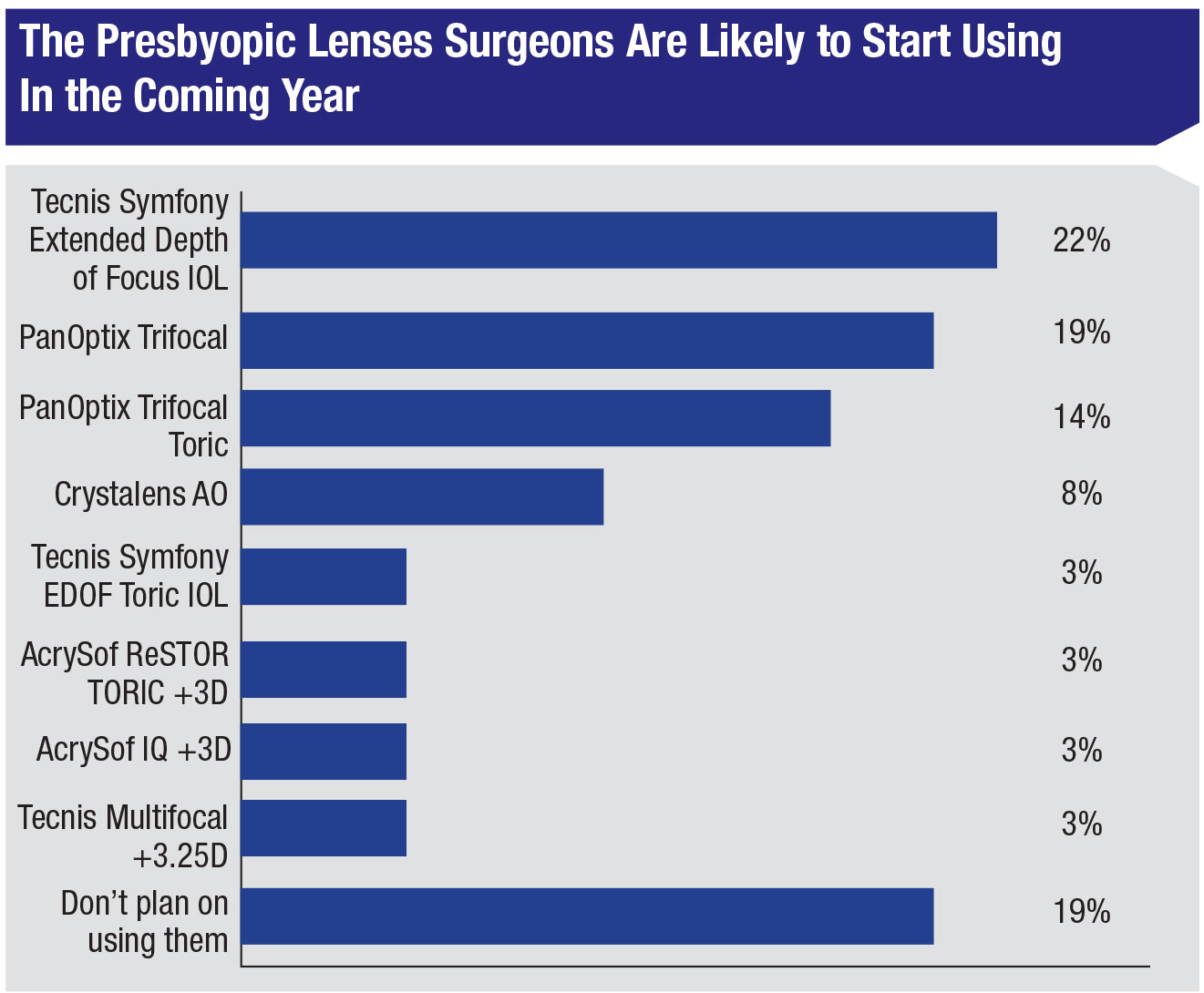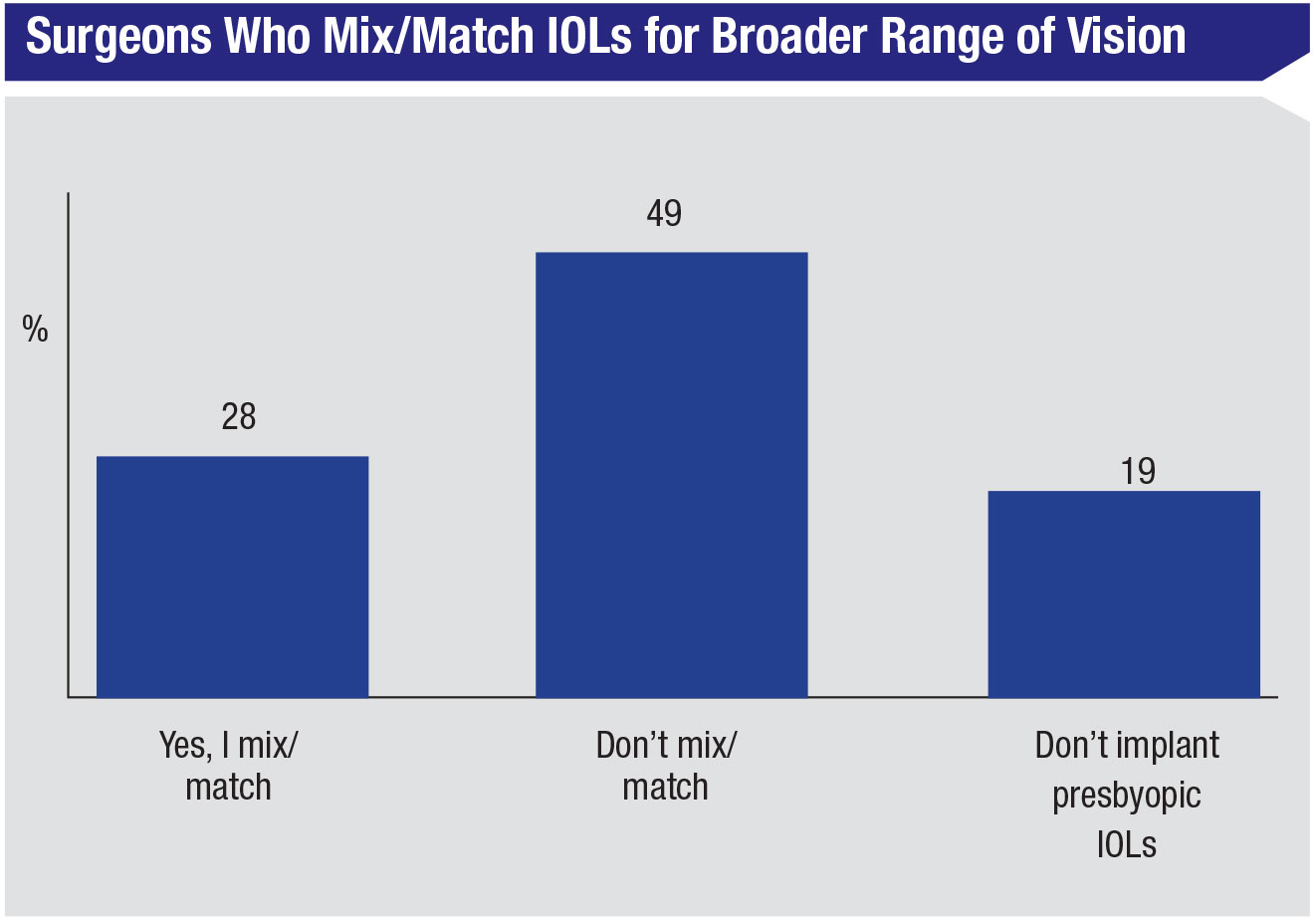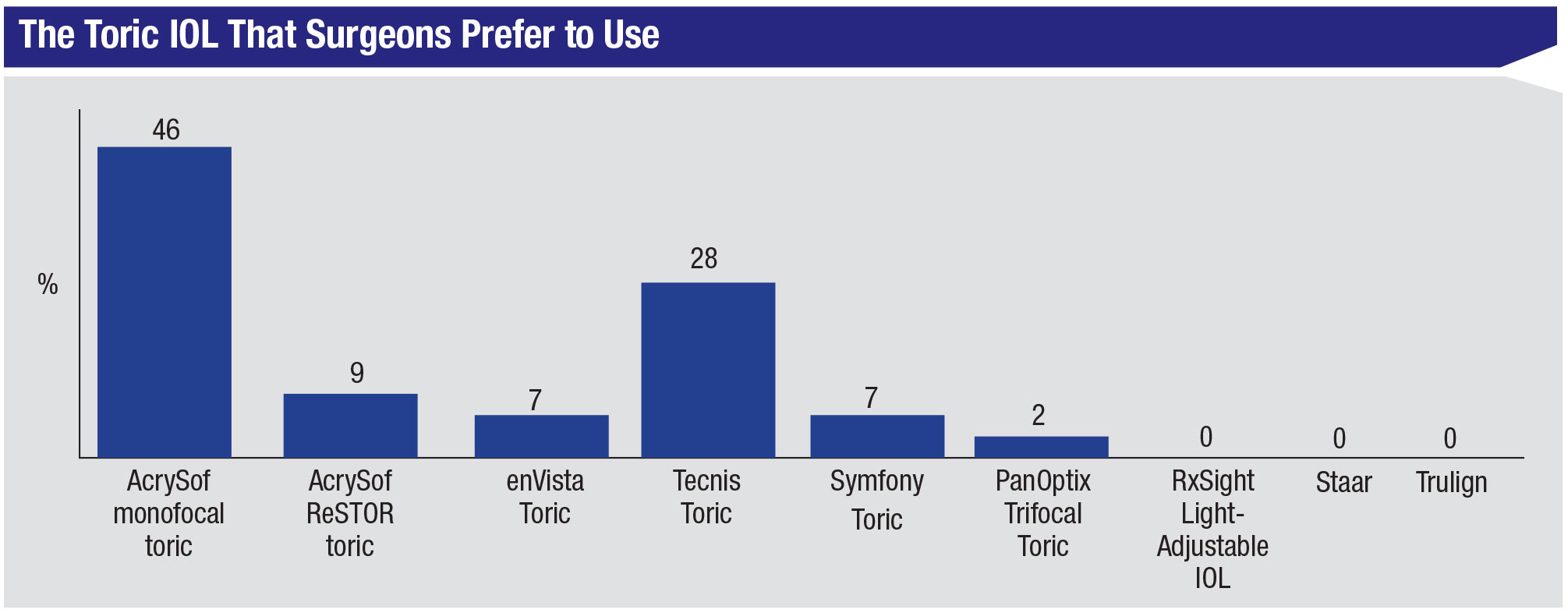This year’s survey on attitudes toward various kinds of intraocular lenses reveals that surgeons are intrigued by the new premium lens options, such as the PanOptix trifocal, and also see a lot of value in offering a toric lens to appropriate astigmats. They’re also looking for ways to mimimize dysphotopsias with their monofocal lens options, and are getting back into “mixing and matching” presbyopic IOLs.
These are some of the findings from this year’s e-mail survey on IOL preferences. This time around, 12.7 percent of the 11,616 recipients on Review’s e-mail list opened the message, and 47 surgeons took the survey. To see how your approach and opinions compare to theirs, read on.
Monofocal Update
As in years past, ease-of-use and minimal dysphotopsias are important factors for surgeons when they choose a monofocal intraocular lens.
In terms of percentages, 37.5 percent of the respondents say they use the Johnson & Johnson Vision Tecnis 1-piece the most, followed by a third who use the Alcon IQ Aspheric IOL. Another 8.3 percent use the Bausch + Lomb enVista lens, 4 percent use the Hoya iSert and 2 percent each use the B+L SofPort AO, B+L Akreos and RayOne Aspheric.
A surgeon from Oregon who primarily uses the Tecnis says, though he likes the lens overall, “One, I don’t like the dysphotopsias and, two, I don’t like that the haptics routinely stick together requiring additional intraocular maneuvers.” Another Tecnis surgeon says he likes the Tecnis’ “visual outcomes, pre-loaded injector, safe unfolding and stability in the capsular bag.” He doesn’t like that he “needs to enlarge the 2.2-mm incision.” A Texas surgeon says he appreciates the lens’s “excellent vision, ease of insertion and accurate postop results.”
On the other side of the fence, a Tennessee surgeon outlines why he likes to use the Alcon IQ. “I love the handling of the lens,” he says. “I don’t like the high index of refraction and the potential for glistening.” An Ohio surgeon who uses the Alcon lens says, “I like the ease of use, the refund policy of Alcon and the lens clarity.” An ophthalmologist from Minnesota says she reaches for the Alcon lens due to its “predictable results.”
One of the surgeons who likes the B+L enVista lens says, “I like everything: It’s clear with no glistenings; easy to handle; and has the same prescription across the entire lens.” A surgeon from Maryland feels similarly, saying, “I like the glistening-free optic and the ease of insertion.”
Presbyopia-correcting IOLs
In this year’s survey, surgeons provided the average number of implantations of the presbyopic IOLs they use the most, as well as their average charge. Some surgeons selected more than one lens.
 |
The most popular option, with 53 percent of the surgeons choosing it, is the Tecnis Symfony (non-toric) (average number implanted per month: four; average charge/eye: $2,326). The Tecnis Symfony Toric was next, at 39 percent (average number/month: 2.5; average charge: $2,359). The Alcon PanOptix trifocal was the third most popular choice, used by a third of the respondents (average number implanted/month: 8.4; average charge/eye: $2,533). Twenty-five percent of respondents say they use the AcrySof ReSTOR Toric +3D (average number/month: two; average charge/eye: $1,712. The Tecnis MF +3.25 D (2.5 lenses implanted per month with an average charge of $2,133) and the PanOptix toric (5.6 lenses implanted per month, with an average charge of $3,500) were each chosen by 19 percent of the surgeons. The Crystalens AO was chosen by 14 percent (nine lenses per month implanted; average charge: $2,300).
A Symfony user from Michigan says he’s “somewhat” satisfied with the lens. “The Symfony IOL still requires reading glasses,” he says, “and some people do get significant haloes.” A surgeon from Kansas agrees, saying his patients have experienced “nighttime glare and inadequate reading vision.” A surgeon from Texas though, is very satisfied with the Symfony lens. “It has an excellent quality of vision, predictable outcomes, is forgiving with residual refractive errors and the material is excellent, with a great safety profile over time compared to the AcrySof material.” One North Carolina surgeon uses the ReStor 3D and both models of the Symfony, and says, “The Symfony has fewer glare problems and excellent distance and intermediate visual acuity. The vision could be improved with better near vision.”
The PanOptix trifocal lens, a recent addition to the presbyopic IOL market, has some surgeons reconsidering their options. A surgeon from Ohio says his ReStor 3D patients have halo complaints, “but the PanOptix is supposed to have fewer of those kinds of complaints.” A surgeon from Tennessee has been using the PanOptix: “Patients seem very satisfied with the lens,” he says. “But, haloes remain a concern.” A PanOptix surgeon surgeon from Ohio says he’s, “still having issues with night vision.”
The concept of mixing IOLs to help give a wider range of vision has re-entered the conversation recently with Johnson & Johnson Vision promoting its “personalized vision” approach to lens selection. In this year’s survey, 29 percent of the respondents say they mix lenses, about half (51 percent) don’t mix them and the rest don’t implant presbyopic lenses.
The surgeons weighed in on mixing lenses. “In the past, I have mixed and matched lenses,” says a surgeon from California. “I’ve mixed a Symfony with a multifocal for those patients who need more near vision. With PanOptix, I’ve not yet mixed.” An Ohio surgeon has worked along these same lines, saying he’s mixed a ZLB00 and a Symfony. “This approach maximizes the range of near vision and reduces night issues somewhat,” he says. One surgeon says he, “tries EDOF … then if the patient wishes a closer near point I’ll use a 3.25-D lens [in the other eye].”
Some think that the advent of trifocals may minimize the need to mix lenses. “This is an obsolete question now that the PanOptix is out,” declares a surgeon from Indiana. Another surgeon has mixed ReStor lenses before, but may change tacks. “I’ve mixed the Alcon 2.5 and 3 D,” he says. “I’ve just begun using the Alcon trifocal, so it’s not necessary to mix.” One surgeon however, doesn’t mix any kind of lenses, saying, “I’m worried patients may find it too weird.”
 |
Looking down the road, surgeons also commented on presbyopic lenses they may be using in the future. In terms of the answers with the largest percentages, 22 percent say they may use the Symfony, 19 percent are considering the PanOptix (14 percent specify the toric version) and 8 percent may use the Crystalens AO. Nineteen percent say they don’t plan on using presbyopic lenses.
A Symfony user from Michigan says he’ll try the PanOptix because “it supposedly has good vision throughout the entire visual range.” One surgeon is looking at the Symfony for similar reasons. “Apparently, it has less dysphotopsia, accepts decentration and decreases contrast sensitivity less,” he says, “but I’m still not sure this is real.”
Toric IOLs
When tackling astigmatism with an IOL, the most popular option on our survey is the AcrySof monofocal toric, chosen by 46 percent of the respondents. Twenty-eight percent prefer the Tecnis toric, 9 percent use the ReStor toric the most and 7 percent choose the Symfony toric. (Neither the Tecnis Toric II nor the enVista toric MX60ET were available when the survey was sent out.)
 |
A surgeon who uses the AcrySof toric says, “I like the IOL’s stability; I don’t like the IOL material.” A surgeon from Georgia agrees, saying, “It’s very stable in the eye, [but I’d like] an easier way to rotate it for alignment in the eye.” A New Jersey surgeon, though, says he prefers the Tecnis toric because it’s a “great material.” REVIEW






